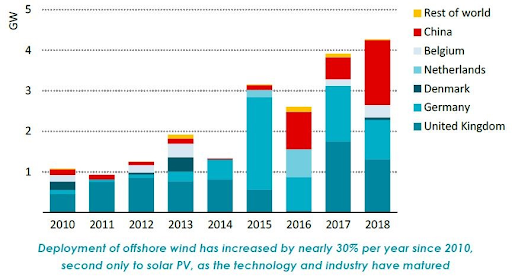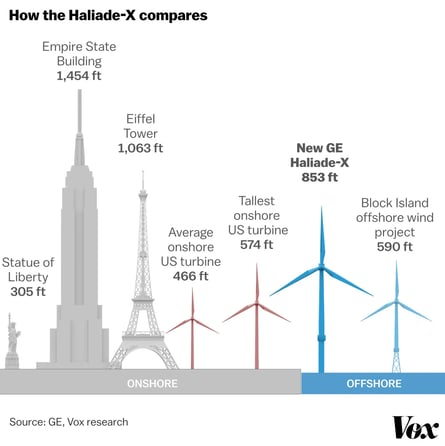Jack Colreavy
- Aug 9, 2021
- 4 min read
Does the wind blow offshore in Australia?
Renewable energy keeps going from strength to strength in Australia. In fact, according to a report by the Clean Energy Council of Australia, 2020 saw renewable energy comprise a record 27.7% of all energy generation. If you dig down further you’ll find that wind energy was the biggest contributor to this, making up 35.9% of all renewable energy generated in Australia. That is 22 TWh of generation, enough to power almost 5 million Aussie homes for the year.
What I find most interesting from this statistic is that 100% of the wind energy generated is from onshore wind farms. Australia doesn’t have one active offshore turbine contributing to our network. This is in stark contrast to other parts of the world with the UK leading offshore wind generation with ~10.5 GW of installed capacity as of 2020, followed by China with ~10GW and the rest of Europe pretty much making up the residual 15GW of the 35.5GW of global offshore wind capacity.
 It appears the reason for Australia’s lack of love for offshore wind power is due to our low population density and the lower cost of onshore wind generation versus offshore. Notably, the levelised cost of energy (LCOE) is materially higher for offshore than onshore wind power. According to Lazard research, the LCOE for offshore averages US$86 per MWh while onshore averages US$40 per MWh.
It appears the reason for Australia’s lack of love for offshore wind power is due to our low population density and the lower cost of onshore wind generation versus offshore. Notably, the levelised cost of energy (LCOE) is materially higher for offshore than onshore wind power. According to Lazard research, the LCOE for offshore averages US$86 per MWh while onshore averages US$40 per MWh.
“Proponents of offshore wind justify the higher cost given that the most common complaint about onshore wind generation is the visual and noise pollution it creates which usually results in resistance by locals to their erection in more densely populated areas.”
Jack Colreavy, Corporate Finance Associate
Onshore wind farms also need more careful analysis of wind currents and speeds which lowers their capacity factors and limits the areas feasible for onshore wind. Moreover, offshore wind turbines have fewer constraints on turbine height and blade diameter. As a result, emerging offshore wind turbines are on a strong positive growth trajectory which will see their size and capacity double, when compared to onshore turbines, and bring down the LCOE as capacity factors increase making them more financially competitive. In February 2021, Danish wind turbine manufacturer Vestas announced the world’s largest wind turbine, the Haliade-X, with a nameplate capacity of 15MW, a rotor diameter of 236 metres, and the potential to generate 80 GWh per annum in high wind sites.
It is no secret that Australia is a future renewable energy powerhouse. The lucky country is blessed with space, sunshine, water, and wind; all the pieces necessary to form a reliable energy network built upon renewables. Adding to this renewable energy resource is our extremely strong offshore winds that occur in shallow water relatively close to shore; a perfect recipe for high-quality offshore wind generation with ‘technically accessible’ resources of over 2.2 TW.
The tide may be turning for offshore wind in Australia with 10 projects in various stages of development, with a combined generation capacity of ~25 GW. The largest and most advanced is the A$10 billion Star of the South wind project. Located off the coast of Victoria, the 2.2GW wind farm would be one of the largest in the world and have the capacity to run 1.2 million homes. But don’t hold your breath on the project being completed anytime soon with an estimated completion date of 2030 thanks to the huge regulatory burden imposed on offshore wind by the Australian government. Nonetheless, the potential for offshore wind in Australia is enormous and should develop as we push to a carbon-neutral future by 2050.
Read the Conversation:
Jack Colreavy:
“ Many people may not know this, but wind energy generation is Australia's largest source of renewable energy. What's more interesting is that all of that wind energy is generated from onshore sources, not offshore. This is in stark contrast to the UK, which leads the world in offshore wind generation with over 10 gigawatts of capacity.
Now Australia's lack of love for offshore is primarily due to our low population density. We have plenty of space to be able to deploy onshore wind turbines. Now, while offshore wind turbines are more expensive, there have been huge developments in the technology, thus increasing the capacity and lowering the cost of generation.
This is great timing considering legislation has finally been tabled by the Federal Energy Minister Angus Taylor, to allow offshore wind generation in Australia, thus unlocking our technically accessible offshore wind resources of over 2.2 terawatts. To learn more about offshore wind generation in Australia, visit bpctimes.com.au.”
Stay ahead of the game and be in the know!
Every Tuesday afternoon we publish a collection of topics and give our expert opinion about the Equity Markets.
Share Link








